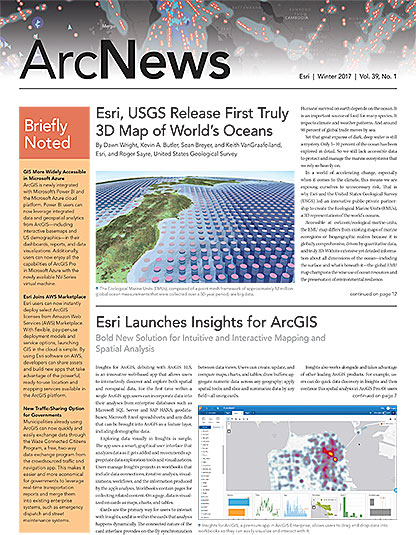Spatial thinking and geospatial technologies are important for today’s students for a number of reasons. Many problems have significant spatial components or present themselves spatially. Long-term studies of people who have entered careers in the fields of science, technology, engineering, and mathematics (STEM) have shown that these individuals possess strong spatial thinking and problem-solving skills. And geospatial technologies are a very accessible platform for problem-based learning.
Spatial thinking cuts across K–12 curricula. So shouldn’t everyone be doing it? Absolutely. However, because it isn’t pegged to a specific area of study, no one discipline is a champion for it. All too often, then, spatial thinking and geospatial technologies don’t get brought into the classroom.
Interestingly, though, the world rarely presents problems that are split cleanly into the fields of physics, chemistry, biology, or engineering. The problems we need to solve combine disciplines and very often have a spatial component. So maybe it is time to rethink how we are teaching STEM courses, rather than grafting on different technologies.

At James Madison University (JMU), we have been involved in a variety of projects for more than 20 years to introduce K–12 students to geospatial technology. Many of these initiatives have focused on providing curriculum and professional development for teachers of grades 4–12. Some have involved direct teaching, such as when I was engaged in a coteaching effort with the Department of Defense Dependent Schools in Germany, where I cotaught lessons with teachers to introduce GIS to their students. Through all these efforts, we have focused on partnering with teachers to provide them with what they need to make good things happen with their students.
In 2005, JMU adjunct professor and Esri K–12 trainer Kathryn Keranen and I developed the Geospatial Semester to help high school seniors reclaim their final semester of school. Instead of enduring the doldrums of those last few weeks before graduation, we envisioned students engaging in a project-based class that would help them get ready for the transition to higher education or work. The class is taught by a teacher at the students’ high school, and JMU faculty make regular visits to mentor the teacher and the students in the use of geospatial technologies. The high school seniors have an oral midterm and give final presentations to JMU faculty, and they can earn JMU credits for the class.
When the Geospatial Semester started, it was implemented at just four high schools scattered across the state of Virginia. My colleagues and I learned a lot about what K–12 teachers and schools need to innovate. We also discovered how much interest teachers had in geospatial technologies.
Over the years, we’ve seen some first-rate work. Many students have gone on to get internships and jobs in geospatial fields. Four of them even presented at the Plenary Session of the 2012 Esri User Conference. As a result of the program, we’ve seen an increase in the number of geographic science majors at JMU—and current enrollment is at an all-time high. Additionally, nearly 3,000 high school seniors have earned JMU credits for the class.
Through the decade-plus of the Geospatial Semester, we have seen hundreds of fascinating projects that employ geospatial technologies and feature spatial thinking. We have watched a number of students with special needs use geospatial technologies to help motivate their STEM learning. And we’ve seen students alter their career trajectories toward geospatial fields.
Something very interesting is happening with all this. But at the end of the day, all we had were these stories. We had very little hard data to back any of this up.
That is why we put together a project to carefully analyze what is actually going on. Working with psychology professors Adam Green from Georgetown University and David Uttal from Northwestern University, and with funding from the National Science Foundation, we are looking at what happens to Geospatial Semester students’ spatial thinking skills from the start of the class through its culmination, comparing any changes in behavior or cognitive skills to similar students who are not taking the course.
To do this, we are administering spatial thinking tests, assessing students’ projects, and interviewing them. We are also taking a group of students to Georgetown to undergo testing in an fMRI machine so we can get a sense of changes in their brain function. We believe that this is the first time anyone has looked at functional neuroimaging to assess a K–12 curricular change, so we are very excited to see the results. Should we find that the use of geospatial technologies brings about a positive effect, it could have a dramatic influence on the adoption of these tools in the K–12 setting. At long last, we might have the kind of quantitative data that supports the use of geospatial technologies in primary and secondary schools.
That is not to say that we won’t still face hurdles. The two greatest challenges to gaining extensive use of geospatial technologies in K–12 schools are high-stakes testing and an overly dense curriculum. We seem to have lost the forest for the trees in K–12 education, so it is difficult to get teachers’ attention. And while there are some very interesting pockets of activity in getting geospatial technologies and education into schools, we have not yet managed to scale them up. The Geospatial Semester was designed so that other universities could adopt it in their service areas. But to date, only Pacific University in Oregon has done the experiment.
We are hopeful, however, that the availability of ArcGIS Online will help motivate teachers to introduce geospatial problem solving earlier in the curriculum and develop demand among students to delve deeper. In fact, Loudoun County schools in Virginia are doing an extended rollout of ArcGIS Online at younger grades, and we are working with them to see how this affects Geospatial Semester enrollment.
What we do know is that kids will flourish with geospatial technology if given the chance. The challenge, then, is to offer those opportunities to students of a variety of ages and work with them to develop their spatial thinking skills. As GIS professionals know, the technology is just the beginning for spatial problem solving.
Helping K–12 education evolve is not an easy task. It requires hard work and perseverance from both inside and outside the system. A combination of student, parent, and industry demand coupled with solid research will start to break down some of the barriers we have encountered so far. We also need to continue to work with universities and their colleges of education to set up the next generation of teachers who will successfully bring geospatial technologies into their classrooms.
About the Author
Robert Kolvoord, PhD, is dean of the College of Integrated Science and Engineering at James Madison University in Harrisonburg, Virginia. He became involved with GIS almost 25 years ago. In 2012, Kolvoord traveled to Ghana as the inaugural instructor in Esri’s Education Ambassador Program, which was formed to introduce GIS to secondary students living in developing countries. Together with Kathryn Keranen, he has also authored the Making Spatial Decisions series, which is available from Esri Press.

